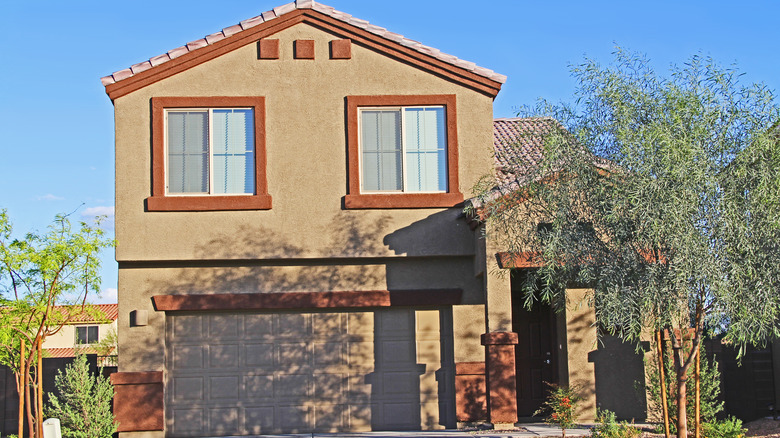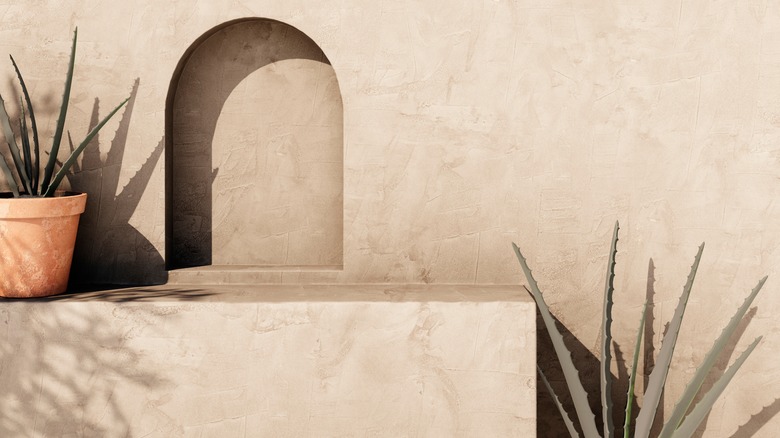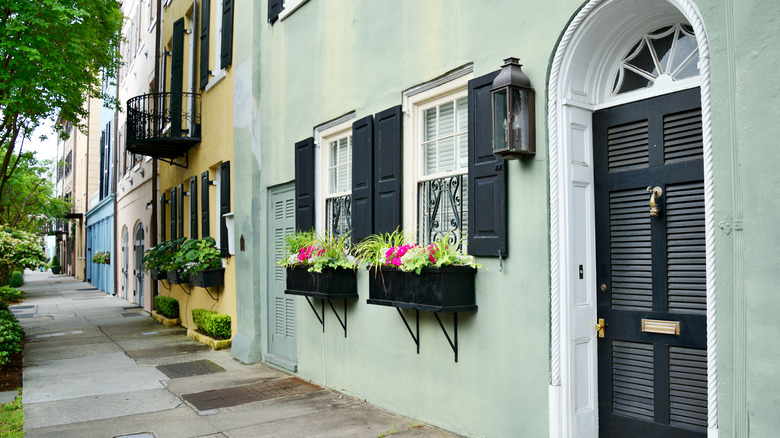What Is Stucco Siding And What Are The Different Types To Consider?
Stucco homes have long been closely associated with the architecture of the American Southwest. It's easy to imagine earthen-colored houses standing against a desert backdrop. However, stucco siding's popularity extends well beyond that region. According to the Census Bureau's Survey of Construction, stucco became the most popular material for new single-family homes in 2023, accounting for 26.8% of new builds — up from 17.3% in 2010. Stucco is followed in popularity by vinyl siding, fiber cement siding, and brick or brick veneer siding, respectively.
Stucco is a building material traditionally made from a blend of sand, water, cement, and lime, with its use tracing back to ancient civilizations. As early as 1400 BCE, stucco was applied to the interior and exterior walls of Greek temples. Its versatility has been seen in a wide range of architectural styles, from Aztec structures in Mexico to Islamic architecture of North Africa and Spain.
Stucco siding offers several benefits. First, it's durable and long-lasting, with a lifespan of over 50 years. It's also resistant to harsh weather conditions, as well as rot, mold, mildew, and even fire. A one-inch layer of stucco can prevent fire from spreading through a wall for at least an hour. However, stucco can be brittle and prone to cracking if a house's foundation settles, making it less ideal for areas with high clay content in the soil. Stucco isn't heavily insulated — providing about 20% of the insulation that wood does — making it less suitable for colder environments. Additionally, while stuck is weather-resistant, it's still important to waterproof it for an added layer of protection.
Traditional vs. synthetic stucco
There are two main types of stucco — traditional and synthetic. Historically, traditional stucco was composed solely of lime, sand, and water. Today, materials like cement and glass fibers are added for enhanced strength and long-lasting durability. Traditional stucco is more durable and fire-resistant than its synthetic counterpart. Traditional stucco is normally applied in three coats: the scratch coat, or base coat, which is followed by the brown coat, which is essentially a second base coat, and finished with a final coat that is typically textured and colored.
Synthetic stucco is more versatile, as it is more flexible and water-resistant, and offers better insulation, allowing its use in a wider variety of climates. Also known as Exterior Insulation and Finish System (EIFS), synthetic stucco does not contain cement or lime, instead using synthetic polymers. With costs ranging from $8 to $14 per square foot fully installed, synthetic stucco is more expensive than traditional stucco, which ranges from $7 to $9 per square foot fully installed. Synthetic stucco, however, requires less maintenance than traditional materials, though any damage in your siding should be repaired immediately to avoid more costly issues.
Different stucco finishes to consider
When it comes to color options, both traditional and synthetic stucco can be painted or colored, but traditional stucco will need to be painted more frequently. The texture of stucco is also highly customizable. A smooth finish is a popular choice for stucco exteriors, admired for its sophisticated and refined look. However, its large, flat surface area makes any imperfections highly visible. An alternative finish, Spanish Lace is favored for its ability to conceal defects and resist cracking, making it one of the most common finishes used in the United States. Despite its practical advantages, some homeowners find the textured appearance of Spanish Lace less visually appealing.
Another popular option is the Cat Face Finish, which features a smooth surface interspersed with rough patches (the 'cat faces'). The look is created by first applying a rough stucco coat, followed by a smooth layer, resulting in a distinctive exterior. However, it's important to note that this finish is labor-intensive and hard to repair.


